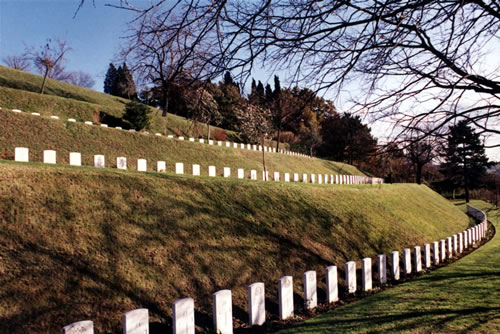Gradara War Cemetery

By the end of August 1944, the Gothic Line had been breached and the Canadians were advancing beyond it. They now prepared to drive to the sea, with the 1st Division charged with scaling Monte Luro, a few kilometres south of Gradara, and then advancing through Gradara and the surrounding region to the coastal highway, Via Adriatica (Highway 16). The 5th Division's objective was Tomba, then San Giovanni in Marignano, to the west of Gradara. Both divisions would ultimately aim to sever the highway and claim the Conca River crossing.
In the afternoon of September 1, Monte Luro was hit with an effective Allied air and artillery bombardment. At 6 p.m. the troops set out, meeting only slight small-arms fire. The Loyal Edmonton Regiment, supported by British tanks, reached the objective with little difficulty, finding the enemy trenches, and machine-gun and anti-tank positions, abandoned. The pursuit force then started on its way. A number of small towns and villages, including Gradara, stood between the Canadians' path and the Conca, and in the darkness of the evening, the troops found themselves confused among the unfamiliar hills of this area. To help, at 2 a.m. on the 2nd, two companies of the Princess Patricias Canadian Light Infantry were dispatched on tanks to intersect a railway 2,000 yards southeast of Gradara and form the division's defensive right flank. This accomplished, a squadron of Royal Canadian Dragoons was able to fight forward to the Via Adriatica. German artillery had set their sights on the Dragoons from their advantageous positions at the Malatesta Castle. The 48th Royal Tanks were therefore sent to capture the town, but the walls of Gradara prevented them from entering. They managed to contain the enemy there, however, and support the Loyal Edmontons' attack on nearby Fanano that evening. The Royal Canadian Dragoons, meanwhile, established a bridgehead over the Conca. At the same time, the Seaforth Highlanders of Canada had made it further up the coast to the outskirts of Cattolica, which they found abandoned, as was Pesaro when the Poles entered it. The end result was that, by September 3, the Canadians had reached the sea and the entire Corps front ran along the line of the Conca. Rimini seemed within reach.
Directions
Located in the commune of Gradara in the province of Pesaro, this cemetery falls between Pesaro (13 kilometres to the southeast) and Rimini (23 kilometres to the north), about 1 ½ kilometres inland of the Adriatic Sea. The massive Castle of Gradara, built by the Malatesta family (the "lords of Rimini") in the 13th Century, overlooks the cemetery from its hilltop position opposite. The site was selected as a cemetery in November 1944, and contains the graves of casualties from the Ancona-to-Rimini advance - which aimed to break the Gothic Line - as well as the battles around Rimini, in the late summer and early autumn of 1944. Many of the fallen gave their lives in September 1944. The vast majority of the 1,192 graves are British or Canadian. In addition, nearly one-third of the 369 Canadian war dead here represent two units - the Royal Regiment of Canadian Artillery and the Royal 22e Régiment (each with 51 burials).
- Date modified: